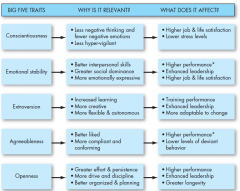![]()
![]()
![]()
Use LEFT and RIGHT arrow keys to navigate between flashcards;
Use UP and DOWN arrow keys to flip the card;
H to show hint;
A reads text to speech;
20 Cards in this Set
- Front
- Back
|
personality
|
the sum total of ways in which an individual reacts to and interacts with others
|
|
|
Myers-Briggs Type Indicator personalities
|
Extroverted or Introverted (E/I)
Sensing or Intuitive (S/N) Thinking or Feeling (T/F) Judging or Perceiving (J/P) Participants are classified within four scales to determine 1 of 16 possible personality types |
|
|
Extroverted or Introverted (E/I)
|
Extroverts who tend to be sociable and assertive Introverts who tend to be quiet and shy.
|
|
|
Sensing or Intuitive (S/N)
|
Sensors are practical and orderly
Intuits utilize unconscious processes. |
|
|
Thinking or Feeling (T/F)
|
Thinking focuses on using reason and logic
Feeling utilizes values and emotions. |
|
|
Judging or Perceiving (J/P)
|
Judgers want order and structure
Perceivers are more flexible and spontaneous. |
|
|
Myers-Briggs weakness
|
These categories, while insightful, are not related to job performance.
|
|
|
Big Five personality model and demonstrated how the traits are relevant to OB.
|

Relevance to OB:
Self-monitoring Adjusts behavior to meet external, situational factors Risk Taking Willingness to accept risk Proactive Personality Identifies opportunities, shows initiative, takes action and perseveres Other Orientation Pay me back vs. pay me forward |
|
|
Values
|
basic convictions that make judgments about what is the best mode of conduct or end-state of existence.
|
|
|
importance of values
|
sets the foundation for many work outcomes such as attitudes, motivation and behavior also, it influence an individual’s perception and cloud their objectivity
|
|
|
terminal values
|
the desired values/goals a person would like to keep/achieve through their lifetime.
Ex. A comfortable life (a prosperous life) Equality (brotherhood, equal opportunity for all) Family security (taking care of loved ones) |
|
|
Instrumental values
|
preferred modes of behavior or means of achieving one’s terminal values.
Ex. Ambitious (hard working, aspiring) Clean (neat, tidy) Forgiving (willing to pardon others) |
|
|
Hofstede’s five value dimensions of national culture
|
Power
Individualism vs. collectivism Masculinity and femininity Uncertainty avoidance Long-term orientation vs. Short-term orientation ** Refer to page 76-77 for chart!! |
|
|
Power
|
distance is the extent to which a society accepts that power in institutions and organizations is distributed unequally
1. Low-distance occurs: relatively equal power between those with status and wealth and those without 2. Higher distance: unequal power distribution between groups. |
|
|
individualism vs. collectivism
|
1. Individualism: degree to which people prefer to act on their own rather than in a group.
2. Collectivism: people operate within a social framework where they help others out and they expect help when they need it. |
|
|
masculinity and femininity
|
Masculinity: culture prefers achievement, power and control vs. characteristics that are more feminine in nature.
|
|
|
Uncertainty avoidance:
|
extent to which a society is willing to live with uncertainty and ambiguity.
1. High uncertainty avoidance: cultures will try to avoid ambiguous situations as much as possible. 2. Lower uncertainty avoidance: cultures do not mind ambiguity. |
|
|
Long-term orientation vs. Short-term orientation
|
1. Long-term orientation: societies will emphasize the future and what it takes to get to the future they desire, thrift and persistence.
2. Short-term orientation societies will emphasize the here and now. |
|
|
The GLOBE framework
|
nine dimensions of national culture
- similar to Hofstede’s model but adds the humane and performance orientations - |
|
|
The GLOBE framework:
humane orientation and performance orientation |
1. humane orientation looks at how much society rewards people for being altruistic and kind
2. performance orientation looks at how much society encourages and rewards good work. |

